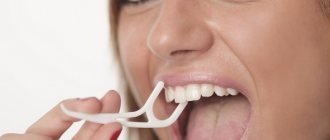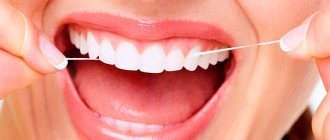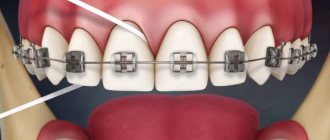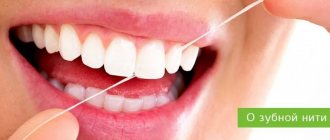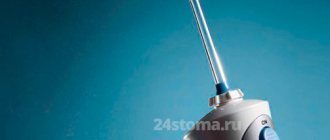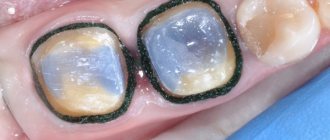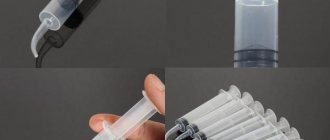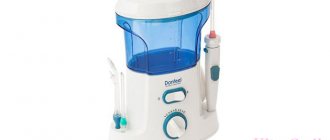Causes of floss getting stuck
Before you figure out how to get dental floss stuck between your teeth, you need to understand why it gets stuck in the first place. Indeed, according to their structure, floss is thin silky threads that consist of many fibers that mechanically remove plaque. Manufacturers make flosses in such a way that they glide well and do not cause injuries. For example, regular flosses are very thin; they can penetrate even the narrowest interdental spaces. Waxed flosses are slightly thicker, but they are impregnated with wax, which improves glide. So what causes dental floss to get stuck between teeth? Let's consider all possible risk factors further.
Incorrect use
Dental floss must be used carefully, slowly moving it into the interdental space (especially if the teeth are very close to each other). There is no need to make sudden “sawing” movements. So, firstly, the enamel and gums are injured, and secondly, the clamped thread will simply break and get stuck.
Poor quality floss
There is a possibility that if a person “runs into” a low-quality product or a fake, even if floss is used correctly, he will find that the dental floss has broken or split. And its fibers or pieces got stuck between the teeth.
Dental disease
It happens that the floss is of high quality, and a person uses it correctly, but the floss still gets stuck between the teeth. This can happen, for example, if there are cracks and microscopic chips on the side (contact) surfaces of the crowns. And also for caries in the same area. Another reason is the growth of tartar in the interdental space, on which the thread clings and breaks. As a result, she gets stuck.
Steps to flossing your teeth
- Wash your hands to prevent bacteria from entering your mouth.
- Tear off a thread with a length of 20 to 45 cm. If you are just starting to use floss, you can measure the length using a ruler.
- Fasten the thread to the middle or index fingers of both hands in turn. There should be a section about 5 cm long between the fingers. One hand fixes the floss, the other secures its remaining part.
- Stretch the floss and carefully insert it into the space between the teeth. Cleaning should begin with forward and backward movements.
- Move the floss from top to bottom, pressing it against the side surface of the tooth. All movements must be neat and smooth.
Remember, each tooth should be flossed with an unused piece of floss to avoid transferring bacteria and plaque. Be careful! When using the floss, do not tug or pull it with force, as this may cut the delicate gums.
What are the consequences
You need to understand that harmful microbes are present in the “narrow” interdental space. Food plaque also accumulates here, in which pathogens “love” to settle. And a floss stuck between the teeth, as well as unsuccessful attempts to pull it out, can lead to the following complications:
- gum injury: bleeding, redness,
- gingivitis, periodontitis, gumboil (periostitis): the transfer of microbes from the thread into the soft tissue provokes superficial inflammation of the gums. Then it invades deeper areas and can “spread” to the gums next to adjacent teeth, to the jaw bone,
- trauma to tooth enamel: a microscopic groove is formed on the lateral surface of the crown, which subsequently deepens. Then microbes penetrate the enamel, causing the development of caries.
Dental floss: harm or benefit
Like any other oral hygiene product, floss has its pros and cons, so in some ways dental floss is harmful, but no more so than a toothbrush, since only its improper use can have a bad effect on dental health.
Pros of dental floss:
- Deep and complete cleaning of the interdental space, unavailable to any other dental hygiene products;
- Easy to use, does not require special skills or additional cleaning products;
- Availability and prevalence of this tool;
- The ability to practice oral hygiene in any place convenient for you, without water or toothpaste.
- If used incorrectly, it can damage the gums and introduce bacteria from dental plaque;
- If used too often, it can destroy interdental protective barriers, which can lead to serious consequences and even tooth loss.
Again, dental floss can cause harm only if it is used incorrectly, and not on its own, as is sometimes believed. Thus, if used correctly, it can only be beneficial if you are not allergic to its components.
What to do if the floss gets stuck
How to remove dental floss if it is stuck between teeth? Here you can first try to get it yourself. The following methods are often used for this:
- active rinsing of the mouth with water,
- washing the interdental space with an irrigator or a stream of water from a syringe (without a needle),
- you can try to remove the problematic piece with a new thread (sometimes it is better to use a thinner floss),
- if it’s not a lint that’s stuck, but the whole floss seems to be “jammed,” then you need to carefully cut it off on one side and pull it out,
- You can use clean tweezers.
“Somehow my dental floss got stuck. It just tore and that’s it, both halves remained in my hands. But I feel like something is getting in the way. I tried to pull it out with another thread, and that one also broke. In general, there was no way they could get it from there. The next morning I started to feel pressure on my teeth and had to go to the dentist. They got her there in one fell swoop.”
Lisa_0101, review from the woman.ru forum
Doctor's advice
You should not be negligent in matters of oral health.
Having received a free consultation with a specialist, the patient will find out whether there is a need for treatment or replacement of old fillings with new ones. It is good to remove tartar using a professional method twice a year. When choosing treatment or prevention, you should not just contact an old and proven clinic. The staff there may change. The best thing is to know a tested and well-established dentist. To this day, there are still free dental care offices. But the doctors working there earn very little, which means good specialists do not stay there. High-quality materials do not arrive there due to lack of funds. Don't skimp on your health! In case of complex problems with stuck food, contact a trusted clinic.
Hi all! The other day I had a real nightmare that continues to this day. I'll start from the beginning. 3 years ago I decided to take care of my teeth (so to speak) and get them in order. I made an appointment at a dental clinic, where they reprimanded me: they said that I was bad at removing food particles from my teeth. I was surprised, because... I brush my teeth and tongue very carefully 2 times a day (and sometimes more often) and rinse my mouth thoroughly. I was advised to use dental floss. Before that, I used a regular toothpick and, may my teeth forgive me, regular floss.
I bought dental floss at the pharmacy, which I am now writing a review about. She completely satisfied me for several years. She held on for a long time. One lasted me 3 years. It cost about 100 rubles back then. It ended recently, and I went to the same pharmacy for the same thread, because... I usually think like this: why look for something new if you have already found something that satisfies you. I drank it for about 150 rubles. I did not floss every day, so as not to damage my teeth and gums. I noticed that the thread deteriorates quickly and falls apart. This didn’t happen with the previous thread; it was high quality and durable. And the night before yesterday after dinner, I decided to brush my teeth with floss, because... Meat got stuck in my teeth (may my readers forgive me for such details), and the thread broke! Moreover, it partially remained between the teeth. To pull it out, I used the floss again, and again it broke and also partially remained between the teeth. I was shocked. I tried again, and what do you think? The same thing happened. I felt discomfort due to the fact that I still had pieces of thread there that I still had not pulled out. I'm thinking of going for a teeth cleaning and asking the dentist to pull out these threads before my gums become swollen and my teeth hurt. I think this is all due to changes in product quality. Therefore, I do not advise anyone to purchase this thread. In general, I’m thinking of switching to dental plates. They say they are better and more convenient than thread.
What you shouldn't do on your own
Sometimes you can hear or read that stuck dental floss is removed using a fishing line. There is no need to do this, because the fishing line is solid (and floss consists of several twisted threads) and is very strong - that is, it can seriously injure the tissues of the oral cavity. Also, do not use a needle, toothpick, fork tine or knife - one careless movement and injury is guaranteed, or the thread will get stuck even more.
Good to know! As for chewing gum, it can help push out a piece of floss or “stick” it to yourself. But provided that it is not stuck very deeply. However, it may happen that the chewing gum pulled out the floss between some teeth, and pushed the same piece deeply between others - so it got stuck again.
Consequences of food stuck between teeth
The result of constant jamming is that the teeth lose their hardness.
And there is a negative progression in this problem. The food penetrates further into the pocket, deepening it, and the bone is affected. Tooth decay occurs when food gets stuck between adjacent teeth. It doesn't show up right away. And treatment is complicated by poor access to the lesion site. The damage caused by stuck food is irreversible. Not only the tooth suffers, but also the tissues supporting it. If left untreated, its destruction and removal cannot be avoided. When stuck food sits in your mouth for a long time, it can ferment and cause an unpleasant odor.
When do you need dental help?
Even a small piece of dental floss can cause quite dangerous and painful pathologies [1] that require timely treatment. Therefore, it is necessary to remove this piece. If you can’t get it at home, you need to see a dentist as soon as possible. A professional will be able to remove it quickly and without problems, especially if he has a special microscope at his disposal.
Read on the topic: a microscope for teeth - an expensive whim of a dentist or a guarantee of quality treatment?
The doctor will also find the reason why the floss is stuck. If the cause is caries or tartar buildup, then appropriate treatment or professional oral hygiene will be carried out.
How is the problem corrected in the clinic?
The main thing in treatment is the correct formation of the contact point. A wide variety of matrix systems and filling materials will help to successfully treat caries. The filling must not only be placed, but also given the correct shape in order to achieve tight contact with the adjacent tooth. If the problem of food getting stuck is caused by an overhanging edge of the filling because the previous dentist gave it the wrong shape, then the filling will be changed. Dentures of unsatisfactory quality must be replaced. “Black triangles” and deep pockets are corrected by dental surgeons. There is no way around it without surgery. Teeth crowding, spasms and diastema can be corrected with orthodontic therapy. To eliminate these defects, it is better to use the method of aesthetic restoration of teeth with crowns, veneers and fillings. Tartar is removed using a special procedure using a professional method, followed by root polishing.
Using floss for children
Experts recommend teaching children oral hygiene from a very young age. So, a child can brush their teeth on their own from the age of 4 or 5, but it’s worth holding off on using floss.
Recent research suggests that children should be taught to floss from age 10 onwards, as they are less likely to harm themselves at this age.
Experts recommend monitoring your baby at least for the first time while flossing to prevent incorrect actions.
Good oral hygiene is important for healthy gums and teeth. However, brushing alone is often not enough. It is necessary to remove food debris from the interdental spaces. With ineffective oral hygiene, plaque forms after each meal, which leads to caries. In addition, it is not always possible to brush your teeth immediately after eating. The modern rhythm of life simply does not allow this. For example, at work. In this case, it is advisable to use a special floss to clean your teeth. Another name for this device is floss. Doctors advise using it several times a day, as well as additionally cleaning the space between the teeth before bed, after the usual brushing. Why do you need dental floss? It prevents the growth of bacteria in the mouth during sleep. This hygiene aid can be very helpful, but before purchasing the right floss, you should learn how to use dental floss correctly. Types of floss Today there is a wide range of these dental products. The appearance of different flosses is widely presented in the gallery of our website. You can choose the one that suits you by studying the video and photos. Dental floss, depending on the material of manufacture, can be natural or artificial. The first types of products are made from silk, and the second are based on non-natural, but no less durable materials: acetate, nylon or nylon.
Floss is an effective additional means of oral hygiene. When choosing this hygiene product, there is no clear answer to the question of which dental floss is better. The fact is that the bite, shape and condition of teeth are different for all people. Therefore, when purchasing floss, it is better to consult a dentist. Your doctor will individually select one or another type of hygiene accessories. By shape, there are flat, ribbon and round flosses. Using flat devices, it is convenient to clean the narrow spaces between teeth. Round flosses are used for large gaps between teeth, and strip flosses are prescribed for cosmetic defects in the position of the incisors (diastema) or for significant gaps between other teeth (trema). Understanding such a large number of dental devices is, at first glance, not an easy task. However, today many people understand how necessary floss is sometimes. How to choose and how to use this product correctly is worth studying in detail. They also produce voluminous products that, in contact with saliva in the oral cavity, become larger and fluff up. This makes it possible to thoroughly clean the space between the teeth without damaging the soft gum tissue. Some models of cleaning threads are impregnated with wax. This allows the floss to easily glide between your teeth to clean them. Appearance of waxed dental floss Dentists prescribe such waxed products to people who are using such hygiene products for the first time. Wax-coated models are much more convenient to use. They make brushing your teeth comfortable. However, unwaxed floss provides better removal of food debris from the mouth and is better at removing plaque. Such threads are separated into fibers and clean the entire surface of the enamel. There are also threads with and without impregnation. Today flosses saturated with sodium fluoride are produced. They not only perform a hygiene function, but are also an excellent means of caries prevention. These types of floss strengthen the enamel in the part of the tooth surface that is difficult to reach with a brush. Menthol products freshen breath, and threads with chlorhexidine effectively disinfect. Antibacterial floss In this case, you can additionally use therapeutic and prophylactic compositions, covering the dental floss with them yourself before the procedure.
There are dental flosses intended for independent use at home and those that are used only in dental clinics under the supervision of a doctor. Contraindications to the use of floss It should be remembered that self-medication and even simply the wrong selection of hygiene products can play a cruel joke on you. There are a number of dental conditions for which flossing can be dangerous. The main contraindications include: 1. Bleeding gums due to periodontal disease. With frequent intensive use of floss, wounds may appear on the gums and an inflammatory process may develop. 2. Caries. Having cavities in one or more teeth while flossing can also be dangerous. When carrying out the procedure for cleaning interdental spaces, there is a possibility that a piece of the tooth may break off. 3. Crowns or bridges. If you have orthodontic microprostheses in your mouth, dentists recommend using a special superfloss dental floss. This device combines the functions of different types of dental floss. Features of use For those who are purchasing floss for the first time, it is useful to know how to properly brush your teeth with dental floss. This device is produced in special packages complete with a small cutter. Packing Dental Floss Before you floss your teeth, you should make sure you have cut off enough floss. The piece of product that was used to clean one gap cannot be used for other areas. You need to take another piece of thread wound around your fingers. Floss is recommended to be used not only after meals. You shouldn’t neglect such a convenient hygiene product, even if you just drank a cup of sweet coffee. Flossing technique It is important to choose the right dental floss. First of all, it must be strong and not tear when it is pulled out of the gap between the teeth. Sometimes this happens if there are chips or irregularities on the enamel surface. Using floss for children's hygiene Children can be trusted to brush their teeth independently using floss no earlier than 9–10 years of age. At the same time, acquaintance with this oral hygiene product can be carried out much earlier. It is very important to teach your child to brush his teeth correctly. To avoid damage to the gums, the procedure should be carried out under the supervision of parents. It’s better if mom or dad themselves show the child how to use dental floss for the first time. Photos and detailed instructions for using floss can be found on our website. It is very important to learn how to use floss correctly, since incorrect use of this dental instrument can lead to gum injury. During the procedure, you should not make unnecessary efforts. If your gums begin to bleed during brushing, you should immediately stop the procedure and rinse your mouth with a warm saline solution. You can resume cleaning only after the bleeding has stopped. If your gums are injured, it is important to immediately consult a dentist. If you are sure that you need dental floss, a special step-by-step technique will tell you how to use it correctly: 1. You need to prepare a piece of floss 40 cm long. This piece of floss should be enough to effectively clean the interdental spaces. Remember to use a clean portion of the floss for each area. 2. Wrap the thread twice around the middle finger of your right hand. The index finger remains free. This makes the procedure more convenient. 3. Then you need to wrap your left hand with floss so that the piece of thread in the center is 8–10 cm. 4. It is recommended to start cleaning with the teeth on the upper jaw. You need to insert the thread into the spaces between the molars and carefully guide it all the way to the gums. In this case, you cannot put in significant effort. 5. Apply the floss to the enamel and run the thread from top to bottom several times. Then you should repeat these steps with the remaining teeth. 6. Afterwards, you need to pull out the dental floss and wrap the used piece of floss around the finger of your right hand. Place a clean piece of the product into another interdental space and repeat the procedure. This sequence of actions will help you properly clean your mouth when using floss for the first time.
The process of brushing your teeth with floss By following these simple recommendations, you can effectively clean the space between your teeth. If you doubt the correctness of carrying out such a hygienic procedure on your own, consult a dentist. The dentist will help you choose the appropriate type of floss and explain how to use such a tool correctly so as not to injure the gingival nipple. Frequency of flossing How many times a day should you floss? Normally, this should be done after every meal. If you did not have the opportunity to floss during the day, you need to thoroughly clean your mouth in the evening before going to bed. For effective oral hygiene, you need to use dental floss regularly. Ideally, you should brush your teeth with a regular brush, then floss, and then use a mouthwash or herbal balm.
What can replace dental floss?
A large number of people believe that floss can be replaced with regular thread and the effect will not suffer. Dentists, in turn, categorically and unanimously warn against such actions. It is virtually impossible to make floss for brushing your teeth at home. All attempts will lead to oral injuries, infections and visits to the dentist.
If you consider what dental floss is made of, it becomes clear that such a durable and convenient material is extremely rare in everyday life. In addition, dental floss is not so expensive that you would risk your own health by using household substitutes to clean the interdental space.
Kinds. Which is better: waxed or unwaxed?
It is immediately worth noting that any type of dental floss is good at cleaning the interdental space from harmful plaque. However, they are quite diverse and differ according to different criteria.
- The shape of the threads is flat and round. Most users note that flat ones are more pleasant to use and are much more difficult to damage the gums;
- According to impregnation, they are available without impregnation or with aromatic impregnation, bleaching impregnation, etc.;
- By purpose. For home use and those that are used exclusively in dental offices;
- Regular flosses and superflosses for use in special devices for cleaning teeth.
But this thread also has certain disadvantages. So, due to the fact that it glides very well over the surface of the tooth, the cleaning efficiency decreases. Also, wax may remain between the teeth, which is also not a very pleasant factor.
